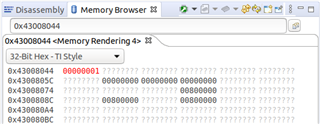I am using a processor with PRU_ICSSG (AM24x, AM64x, AM65x). I am using Code Composer Studio (CCS) to connect to my processor. How do I check what frequency the PRU cores are running at? How do I change the PRU core frequency?
Note: these steps document how to use CCS to set PRU core frequency. CCS is useful when developing and debugging PRU applications. However, different steps will be required to set PRU clock frequency in production code where the PRU is initialized by a Linux, RTOS, or bare metal core.
Setting PRU core frequency from Linux: Reference [FAQ] PRU_ICSSG: How to check and set PRU Core Frequency in Linux?
Setting PRU core frequency from RTOS or bare metal: Use the SOC driver in MCU+ SDK. In MCU+ SDK documentation, reference "SOC Peripheral Drivers" > "SOC". Selecting a specific frequency in PRU-ICSS module in SysConfig adds auto-generated code to call the “SOC_moduleSetClockFrequency” API during initialization. If PRU-ICSS clock frequency needs to be changed later during run-time, the same API can be used again. Note that AM24x/AM64x SysConfig for SDK 8.0 and earlier only give options for clock frequencies 200MHz - 250MHz. AM24x/AM64x SysConfig for SDK 8.1 onwards give the full range of ICSSG clock frequencies from 200MHz - 333MHz (1GHz / 3)



